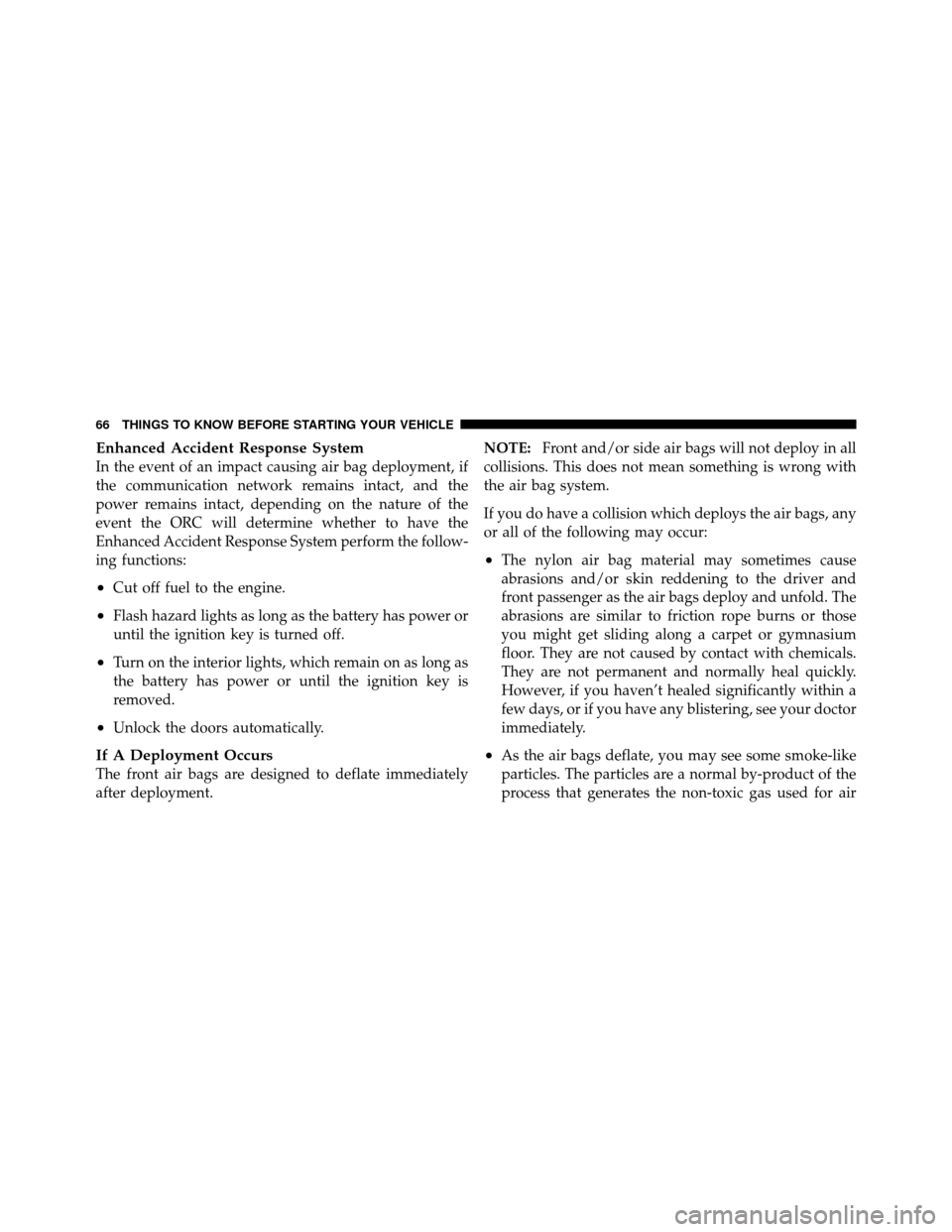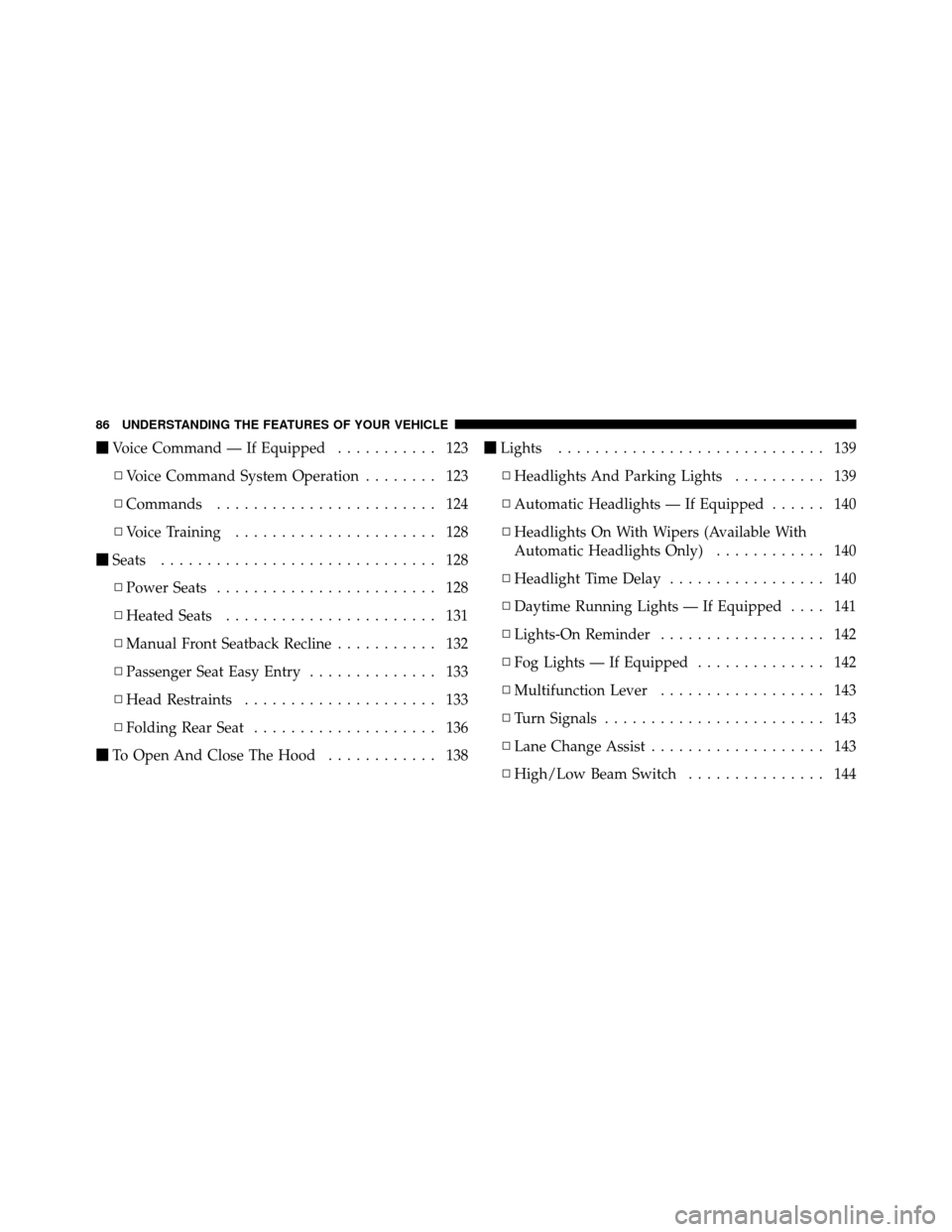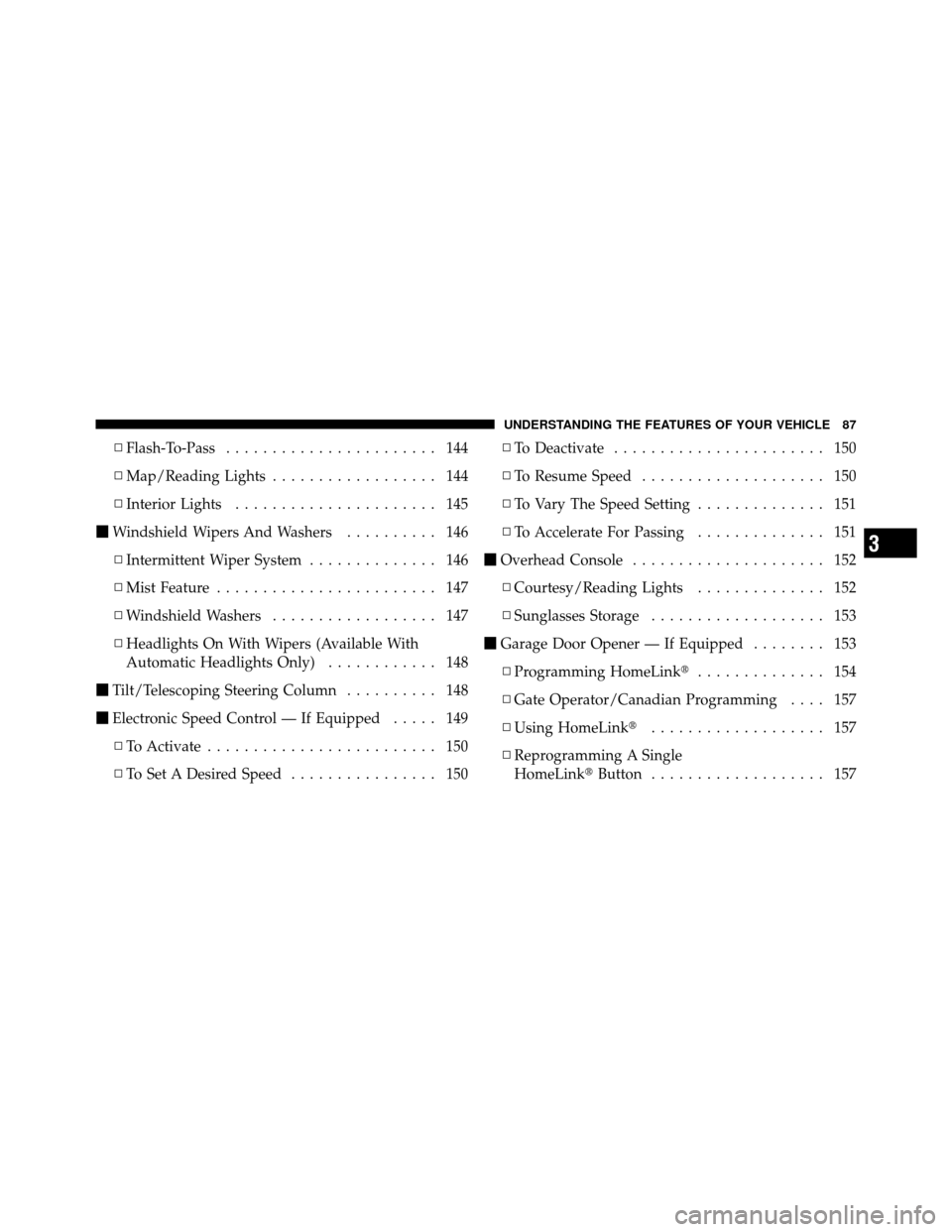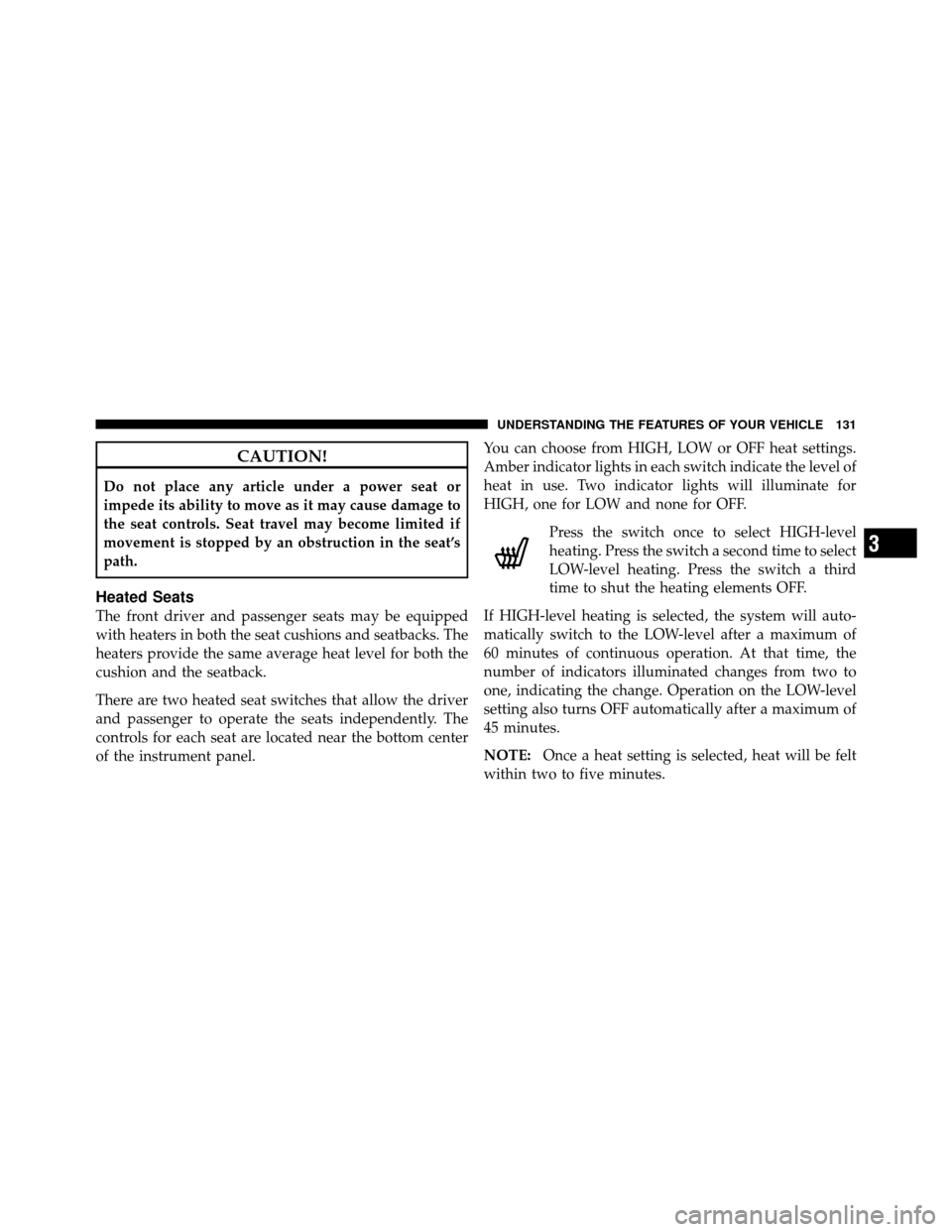Page 32 of 490
Cancel Remote Start
Remote Starting will also cancel if any of the following
occur:
•The engine stalls or engine speed exceeds 2500 rpm
•Any engine warning lights come on
•Fuel lamp turns on
•The hood is opened
•The hazard switch is pressed
•The shift lever is moved out of PARK
DOOR LOCKS
Manual Door Locks
To lock each door, push the door lock knob on each door
trim panel downward. To unlock each door, pull the door
lock knob on each door trim panel upward.If the door lock knob is down when you shut the door,
the door will lock. Therefore, make sure the Key Fob is
not inside the vehicle before closing the door.
Door Lock Knob
30 THINGS TO KNOW BEFORE STARTING YOUR VEHICLE
Page 60 of 490

Advanced Front Air Bag Features
The Advanced Front Air Bag system has multistage
driver and front passenger air bags. This system provides
output appropriate to the severity and type of collision as
determined by the Occupant Restraint Controller (ORC),
which may receive information from the front impact
sensors.
The first stage inflator is triggered immediately during an
impact that requires air bag deployment. This low output
is used in less severe collisions. A higher energy output is
used for more severe collisions.WARNING!
•No objects should be placed over or near the air
bag on the instrument panel, because any such
objects could cause harm if the vehicle is in a
collision severe enough to cause the air bag to
inflate.
•Do not put anything on or around the air bag covers
or attempt to open them manually. You may damage
the air bags and you could be injured because the
air bags may no longer be functional. The protec-
tive covers for the air bag cushions are designed to
open only when the air bags are inflating.
•Do not drill, cut or tamper with the knee bolster in
any way.
•Do not mount any accessories to the knee bolster
such as alarm lights, stereos, citizen band radios,
etc.
58 THINGS TO KNOW BEFORE STARTING YOUR VEHICLE
Page 68 of 490

Enhanced Accident Response System
In the event of an impact causing air bag deployment, if
the communication network remains intact, and the
power remains intact, depending on the nature of the
event the ORC will determine whether to have the
Enhanced Accident Response System perform the follow-
ing functions:
•Cut off fuel to the engine.
•Flash hazard lights as long as the battery has power or
until the ignition key is turned off.
•Turn on the interior lights, which remain on as long as
the battery has power or until the ignition key is
removed.
•Unlock the doors automatically.
If A Deployment Occurs
The front air bags are designed to deflate immediately
after deployment.NOTE:
Front and/or side air bags will not deploy in all
collisions. This does not mean something is wrong with
the air bag system.
If you do have a collision which deploys the air bags, any
or all of the following may occur:
•The nylon air bag material may sometimes cause
abrasions and/or skin reddening to the driver and
front passenger as the air bags deploy and unfold. The
abrasions are similar to friction rope burns or those
you might get sliding along a carpet or gymnasium
floor. They are not caused by contact with chemicals.
They are not permanent and normally heal quickly.
However, if you haven’t healed significantly within a
few days, or if you have any blistering, see your doctor
immediately.
•As the air bags deflate, you may see some smoke-like
particles. The particles are a normal by-product of the
process that generates the non-toxic gas used for air
66 THINGS TO KNOW BEFORE STARTING YOUR VEHICLE
Page 86 of 490
Periodic Safety Checks You Should Make Outside
The Vehicle
Tires
Examine tires for excessive tread wear and uneven wear
patterns. Check for stones, nails, glass, or other objects
lodged in the tread or sidewall. Inspect the tread for cuts
and cracks. Inspect sidewalls for cuts, cracks and bulges.
Check the wheel nuts for tightness. Check the tires
(including spare) for proper cold inflation pressure.
Lights
Have someone observe the operation of exterior lights
while you work the controls. Check turn signal and high
beam indicator lights on the instrument panel.
Door Latches
Check for positive closing, latching, and locking.
Fluid Leaks
Check area under vehicle after overnight parking for fuel,
engine coolant, oil, or other fluid leaks. Also, if gasoline
fumes are detected or if fuel, power steering fluid, or
brake fluid leaks are suspected, the cause should be
located and corrected immediately.
84 THINGS TO KNOW BEFORE STARTING YOUR VEHICLE
Page 88 of 490

�Voice Command — If Equipped ........... 123
▫ Voice Command System Operation ........ 123
▫ Commands ........................ 124
▫ Voice Training ...................... 128
� Seats .............................. 128
▫ Power Seats ........................ 128
▫ Heated Seats ....................... 131
▫ Manual Front Seatback Recline ........... 132
▫ Passenger Seat Easy Entry .............. 133
▫ Head Restraints ..................... 133
▫ Folding Rear Seat .................... 136
� To Open And Close The Hood ............ 138�
Lights ............................. 139
▫ Headlights And Parking Lights .......... 139
▫ Automatic Headlights — If Equipped ...... 140
▫ Headlights On With Wipers (Available With
Automatic Headlights Only) ............ 140
▫ Headlight Time Delay ................. 140
▫ Daytime Running Lights — If Equipped .... 141
▫ Lights-On Reminder .................. 142
▫ Fog Lights — If Equipped .............. 142
▫ Multifunction Lever .................. 143
▫ Turn Signals ........................ 143
▫ Lane Change Assist ................... 143
▫ High/Low Beam Switch ............... 144
86 UNDERSTANDING THE FEATURES OF YOUR VEHICLE
Page 89 of 490

▫Flash-To-Pass ....................... 144
▫ Map/Reading Lights .................. 144
▫ Interior Lights ...................... 145
� Windshield Wipers And Washers .......... 146
▫ Intermittent Wiper System .............. 146
▫ Mist Feature ........................ 147
▫ Windshield Washers .................. 147
▫ Headlights On With Wipers (Available With
Automatic Headlights Only) ............ 148
� Tilt/Telescoping Steering Column .......... 148
� Electronic Speed Control — If Equipped ..... 149
▫ To Activate ......................... 150
▫ To Set A Desired Speed ................ 150 ▫
To Deactivate ....................... 150
▫ To Resume Speed .................... 150
▫ To Vary The Speed Setting .............. 151
▫ To Accelerate For Passing .............. 151
� Overhead Console ..................... 152
▫ Courtesy/Reading Lights .............. 152
▫ Sunglasses Storage ................... 153
� Garage Door Opener — If Equipped ........ 153
▫ Programming HomeLink� .............. 154
▫ Gate Operator/Canadian Programming .... 157
▫ Using HomeLink� ................... 157
▫ Reprogramming A Single
HomeLink� Button................... 157
3
UNDERSTANDING THE FEATURES OF YOUR VEHICLE 87
Page 133 of 490

CAUTION!
Do not place any article under a power seat or
impede its ability to move as it may cause damage to
the seat controls. Seat travel may become limited if
movement is stopped by an obstruction in the seat’s
path.
Heated Seats
The front driver and passenger seats may be equipped
with heaters in both the seat cushions and seatbacks. The
heaters provide the same average heat level for both the
cushion and the seatback.
There are two heated seat switches that allow the driver
and passenger to operate the seats independently. The
controls for each seat are located near the bottom center
of the instrument panel.You can choose from HIGH, LOW or OFF heat settings.
Amber indicator lights in each switch indicate the level of
heat in use. Two indicator lights will illuminate for
HIGH, one for LOW and none for OFF.
Press the switch once to select HIGH-level
heating. Press the switch a second time to select
LOW-level heating. Press the switch a third
time to shut the heating elements OFF.
If HIGH-level heating is selected, the system will auto-
matically switch to the LOW-level after a maximum of
60 minutes of continuous operation. At that time, the
number of indicators illuminated changes from two to
one, indicating the change. Operation on the LOW-level
setting also turns OFF automatically after a maximum of
45 minutes.
NOTE: Once a heat setting is selected, heat will be felt
within two to five minutes.
3
UNDERSTANDING THE FEATURES OF YOUR VEHICLE 131
Page 141 of 490
CAUTION!
To prevent possible damage, do not slam the hood to
close it. Lower the hood until it is open approxi-
mately 6 in (15 cm), and then drop it. This should
secure both latches. Never drive your vehicle unless
the hood is fully closed, with both latches engaged.
WARNING!
Be sure the hood is fully latched before driving your
vehicle. If the hood is not fully latched, it could open
when the vehicle is in motion and block your vision.
Failure to follow this warning could result in serious
injury or death.
LIGHTS
Headlights And Parking Lights
The headlight switch is located on the left side of the
instrument panel. This switch controls the operation of the
headlights, parking lights, instrument panel lights, instru-
ment panel light dimming, interior lights and fog lights.
Headlight Switch
3
UNDERSTANDING THE FEATURES OF YOUR VEHICLE 139